| |
|
It is the remote and
hidden churches that entice me the most, and
Little Wenham church sits more than half a mile
from the nearest road. You reach it by a dirt
track which turns off by the Queens Head pub, and
then meanders through farm buildings and fields
before entering a curious fen-like area, over
which it is a causeway. You do not need much
imagination to detect the remains of a lost
settlement here. At last, it opens out into what
was clearly once an ancient farmyard, with the
church high on its mound to the east.
This churchyard is one of Suffolk's secret
places. The tower, its top repaired in red brick,
stands high above the nave and churchyard. The
porch itself is a little 15th Century wooden
structure, although it does have two unusual
features. Above the entrance, three image niches
are set in the wood, in a way familiar from stone
ones found elsewhere in Suffolk. Also, the
entrance contains slots for a drop-bar gate,
existing elsewhere in Suffolk at Badley, a
similarly remote church. Its purpose was probably
to keep animals out.
But we are able to step inside. This is one of
those churches which thrills with its
idiosyncratic character and richness of interest.
The remains of the medieval stone rood screen,
existing elsewhere in Suffolk only at Bramford,
lead you through to the chancel, where you stand
before some of the loveliest wall paintings
in all Suffolk. Because the church was
built pretty much all of a piece in the middle of
the 13th Century, and because the original early
Decorated east window is still in place, it is
safe to assume that these wall paintings are the
original decorations, painted for the building's
consecration when it was first built.
To the south of the window are saints Margaret,
Catherine and Mary Magdalene. To the north, the
Blessed Virgin and child, flanked by angels. The
most striking thing about these beautiful flowing
figures is that the centuries have oxidised their
skin tones quite black. They are exquisite. 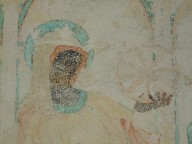 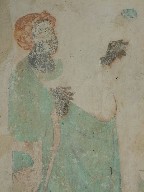 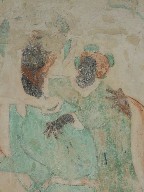 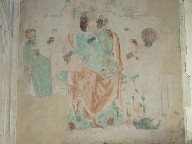
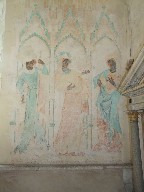 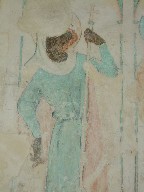 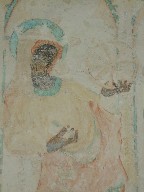 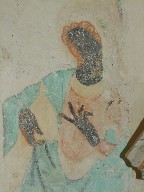 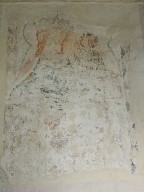
And, as if that were not
enough, the chancel also contains one of
Suffolk's best pre-Reformation pairs of figure
brasses. Thomas Brewse of little Wenham Hall, who
died in 1514 and his wife Elizabeth lie before
the altar, stately and proud, confident in their
position and in the perpetuity in which Masses
would be said for their souls. In fact, those
Masses would last barely thirty years.
Interestingly, someone at some point has
attempted to scratch out the rose shapes on
Elizabeth's girdle. Perhaps they thought it was a
rosary. Beneath them, their children stand, boys
to the left, girls to the right. The girls have
long, flowing hair, showing that they were
unmarried at the time of their father's death.
The Reformation would result in a different kind
of memorial, where civil power could be
legitimately expressed. The Brewses held the hall
into the 18th Century, and were patrons of this
church. Either side of the altar are two other
memorials to them. To the south is John Brewse,
who died in 1585. He is in good condition, and
finely crafted. He kneels at prayer, a different
kind of piety to that of his great grandfather on
the chancel floor. He looks as if he might get up
and walk away at any moment. To the north of the
altar, what was plainly an Easter Sepulchre, a
pre-Reformation tomb for another member of the
Brewse family (it bears an earlier form of the
shield across the chancel) but for which one is
now unknown. However, in 1785 it was
pragmatically reused for John Brewse, a
descendant of the other Brewses in the chancel.
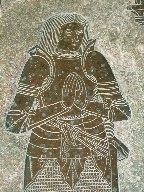
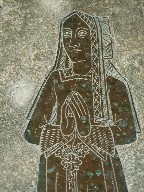 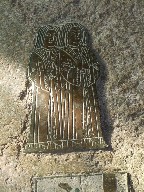
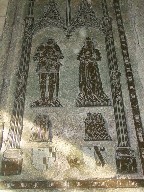 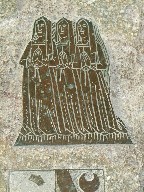
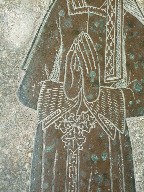
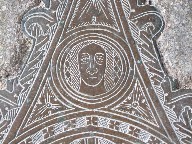 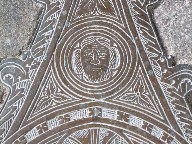 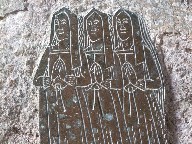
This is a church it's hard
to resist returning to as if it were an old
friend. And yet, it almost didn't survive for us
to see it. In the late 19th Century it was quite
derelict, and a decision was taken to demolish
it. At the meeting held to discuss this, it is
said that the sexton swayed opinion by stating
that "the old girl's been around such a long
time, it seems a shame that she should fall down
now." His eloquence led to its restoration,
and a photograph of this hero can be seen to this
day, beneath the tower arch.
|
|
|

